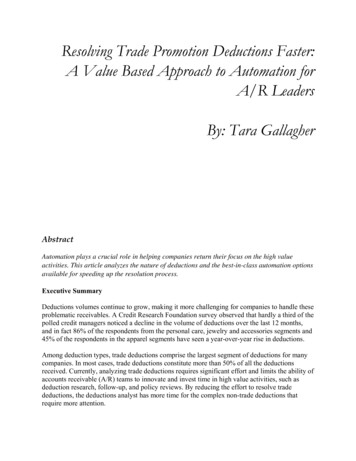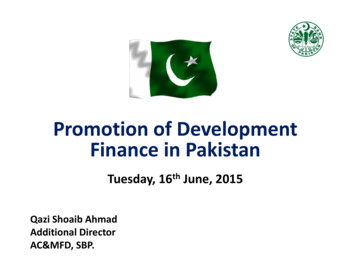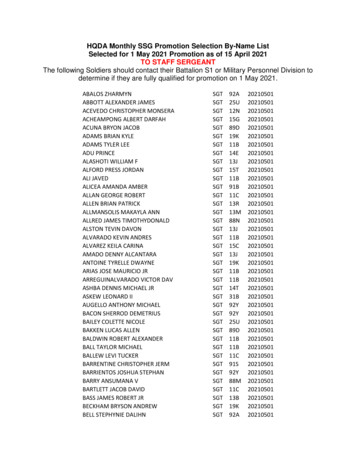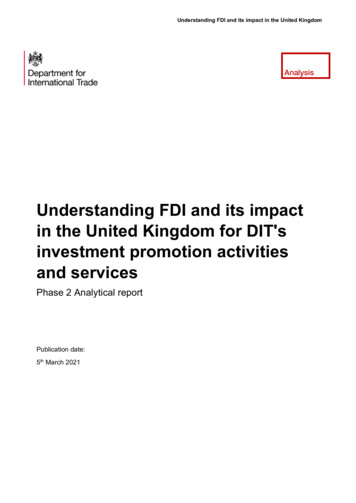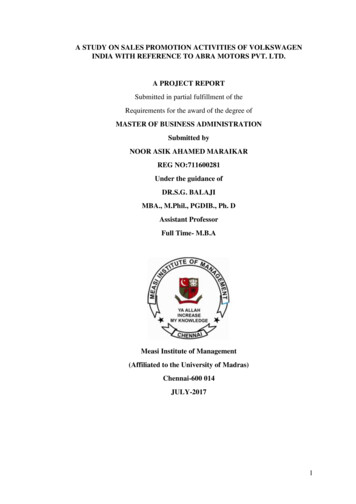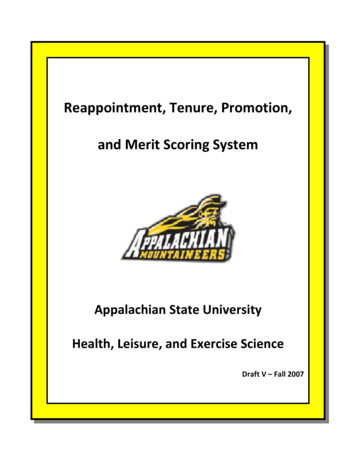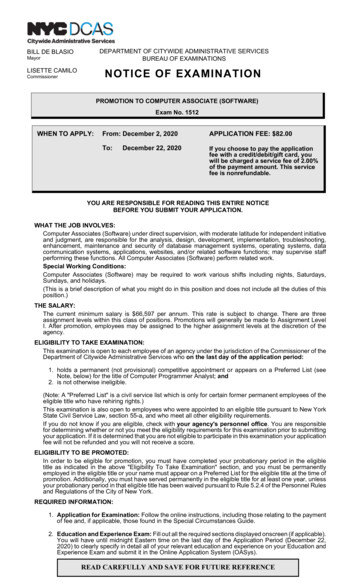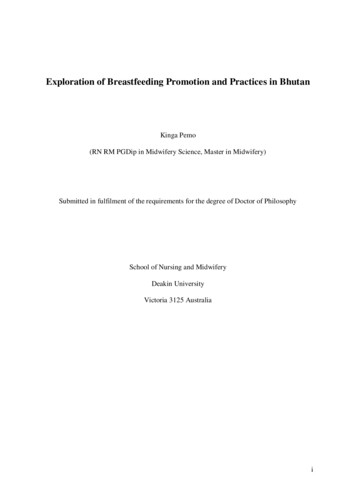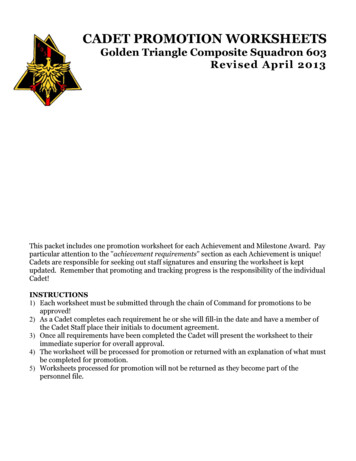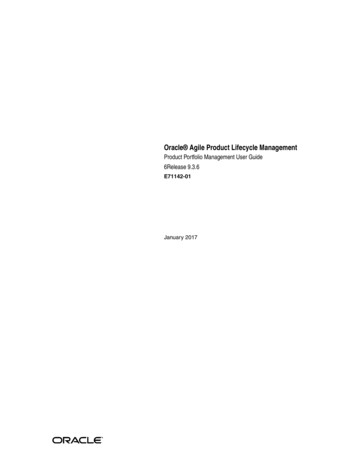
Transcription
International Journal of Education and ResearchVol. 2 No. 9 September 2014Effect of Promotion on Product Awareness(A Case Study of A Reputable Organization in the Brewery Sub-Sector of the Manufacturing Industry)BY1IBOJO BOLANLE ODUNLAMI AND 2AKINRUWA, TEMITOPE EMMANUEL1LECTURER, BUSINESS ADMINISTRATION DEPARTMENT,FACULTY OF SOCIAL AND MANAGEMENT SCIENCES,AJAYI CROWTHER UNIVERSITY,OYO. NIGERIAEmail: odunibojo@gmail.comMOBILE PHONE: 080322101452LECTURER, BUSINESS ADMINISTRATION DEPARTMENT,FACULTY OF MANAGEMENT SCIENCES,EKITI STATE UNIVERSITY, NIGERIA.E-mail: akinruwatea2013@gmail.comMOBILE PHONE NO: 08060738696AbstractThe study examined the influence of promotion on product awareness in the brewery subsector ofthe manufacturing industry in Nigeria. The objectives are; to assess the impact of promotion onproduct awareness in relation to the organization, to determine the degree at which the promotionalmix used by the organization helps in achieving organisational objective, to evaluate the effect ofcompany’s promotional activities on the pricing of a company’s brand and to assess theeffectiveness of promotion in increasing the sales revenue of the organization.Survey research design was adopted for this research. Primary data which includes questionnairewas used to elicit information from the members of staff while secondary data encompasses relatedjournal materials, periodicals et.c. Descriptive statistics (percentages) and inferential statistics(multiple regression and t-test were used) were used to analyse the data.The findings show that a 1% shift in promotion will cause a 52.6% shift in product awareness(r .526**, N 121, P .01). The study revealed that a 1% shift in promotion will cause 89.6% shiftin organizational objectives (r .896**, N 121, P .01). Also, 1% shift in promotion will cause87.4% shift in pricing of organization’s brand/products (r .874**, N 121, P .01). These depict thatpromotion influences pricing of organizations’ product in this study. More so, 1% shift inpromotion will cause 49.6% shifts in sales revenue(r .496**, N 121, P .01).Based on the findings of this study, it was concluded that promotion is a critical and vital factor thatenhances product awareness in the market. Hence, promotion attracts attention particularly whenconsumers are not very familiar with the products. It was strongly recommended that investments451
ISSN: 2201-6333 (Print) ISSN: 2201-6740 (Online)www.ijern.comshould be made towards research and developments as it becomes extremely necessary to considerthe cost/benefits analysis of promotions as past researchers emphasised that promotion is based onmeeting customers’ needs within a short term period.Keywords: Promotion, Product, Product awareness, Marketing mix, Promotional mix andorganizational objectivesIntroduction.It is the desire of every business oriented organization to create a conducive and accessible mediumthrough which their goods and services are known and patronized by the target market. This willgive room for the realization of stated objectives. It is therefore germane to say that businessorganization are set up for the achievement of stated objectives such as profitability, customersatisfaction, product awareness, increase in market share, expansion, growth e.t.c, thereforeorganization must put in place mechanism for achieving their stated objectives .However, objectivesmay vary, it is necessary to state the needed /necessary objectives to be achieved by respectiveorganizations. Having stated the objectives and the mechanism for achieving the objectives, themarketing mix must be given proper attention. Marketing mix which serves as the 4p of marketingis a vital set of elements that links the organization to its target market. The term marketing mix wasfirst popularized by Borden (1964). The ingredients in Borden marketing mix include productplanning, pricing, branding, distribution channels, personal selling, advertising, promotion,packaging, display, servicing, physical handing and fact findings and analysis. Frey (1961)suggested that marketing variables should be divided into two parts: the offering (product,packaging, brand, price and service) and the methods and tools (distribution channel, personalselling, advertising, sales promotion and publicity. On the other hand, Lazer and Kelly, (1962) andLazer, et al (1973) suggested three elements of marketing mix: the goods and service mix, thedistribution mix, and the communication mix.The Borden (1964) ingredients have been regrouped by McCarthy (1964) into the four variablesthat are known today as the 4ps of marketing. These four Ps are the parameters that the marketingmanagers can control, subject to the internal and external constraints of the marketing environment.However, the goal is to make decisions that center on the four Ps and the customers in order tocreate perceived values and generate a positive response.The marketing mix can be used to develop both long-term strategies and short-term tacticalprogrammes (Palmer, 2004). The marketing mix management paradigm has dominated marketingthought, research and practice (Grönroos, 1994), and “as a creator of differentiation” (Van, 1987)since it was introduced in 1940s. Kent (1986) refers to the 4Ps of the marketing mix as “the holyquadruple of the marketing faith written in tablets of stone”. Marketing mix has been extremelyinfluential in informing the development of both marketing theory and practise (Möller, 2006). Themain reasons the marketing mix is a powerful concept are; It makes marketing seem easy to handle,allows the separation of marketing from other activities of the firm and the delegation of marketingtasks to specialists; and – the components of the marketing mix can change a firm’s competitiveposition (Grönroos, 1994). All managers have to allocate available resources among variousdemands, and the marketing manager will in turn allocate these available resources among thevarious competitive devices of the marketing mix. In doing so, this will help to instill the marketingphilosophy in the organisation (Low and Tan, 1995).Product remains the first vital element of marketing mix because it serves as the needs satisfyingpackage. It is therefore necessary to consider the proper vehicle for delivery the needed information452
International Journal of Education and ResearchVol. 2 No. 9 September 2014about the product to the potential customers; this paves room for promotion as a vital element ofmarketing mix in communicating favourable information about the product to the respectivecustomers. It will be a great loss to the managers if their products are not well known by the targetmarket. This will lead to poor sales, and eventually lead to the death of the products, Irrespective ofthe nature of the basic product, the necessity of promotion as a critical tool in creating productawareness cannot be over emphasized. This is based on the fact that people cannot buy product(s)that they are not aware of. This made it necessary for organizations to embark on all possible meansof communicating the effectiveness of their products to the target market.The nature of the products and other factors such as size of the market, concentration of the targetmarket, type of product, scope of the market and so on, are factors to be considered in consideringthe type of promotional tools to be use. These tools are advertisement, sales promotion, personalselling, and direct marketing e.t.c. However, irrespective of nature of the selected tools, the mindsetof manager is to create effective product awareness.According to Kotler (2002) “Promotion compasses all the tools in the marketing mix whose majorrole is persuasive communications. Promotion includes, advertising, personal selling, salespromotion and other selling tools. Promotion is one of the market mix elements, and a term usedfrequently in marketing. The promotional mixes or promotional tools are personal selling,advertising, sales promotion, direct marketing, and publicity. A promotional mix specifies howmuch attention to pay to each of the five subcategories, and how much money to budget for each. Apromotional plan can have a wide range of objectives, including: sales increases, new productacceptance, creation of brand equity, positioning, competitive retaliations, or creation of a corporateimage. Fundamentally, however there are three basic objectives of promotion. These are: to presentinformation to consumers, to increase demand, and to differentiate a product.However, Product awareness is the knowledge about the particular products a company offersespecially compared to those offered by its competitors. When one first hear about promotionalproducts as part of a marketing campaign, one might think that it is a pen with the company’s nameon it. However, promotional products have come a long way and there is a huge variety ofpromotional products that are available to be branded with ones name, logo, phone number,website, etc. It is important when choosing a promotional product campaign that one chooses a typeof product that can easily be identified with one or what it is that one does. Secondly, it is importantthat the product is something that is useful to the recipient. Remember, one can always have onesname, logo, contact information, and even a motto, creed, or saying added to ones promotionalproducts.1.1 Objectives of the StudyThe main objective of this research study is to examine the impact of promotion on product or brandawareness, using a reputable organization in the Brewery IndustryThe objectives of this research are as follows: To assess the impact of promotion on product awareness in relation to the Breweryindustry.To determine the degree at which the promotional mix used by Nigeria brewery helps inachieving organisational objective.453
ISSN: 2201-6333 (Print) ISSN: 2201-6740 (Online) www.ijern.comTo evaluate the effect of company’s promotional activities on the pricing of a company’sbrand.To assess the effectiveness of promotion in increasing the sales revenue of Nigeria breweryproducts.LITERATURE REVIEWFrom Frances and Stephen (2006), Promotion mix is the direct way in which an organizationattempts to communicate with various target audiences. It consists of five main elements:Advertising, sales promotion, personal selling, public relation and direct marketing.Kotler and Armstrong (2006) viewed promotion as activities that communicate the merits of theproduct and persuade target customers to buy it. Promotion mix can be seen as the specific blend ofadvertising, sales promotion, public relation and direct marketing tools that the company uses topursue its marketing objectives.Promotional strategies include all means through which a company communicates the benefits andvalues of its products and persuades targeted customers to buy them (Kotler and Armstrong, 2004).Promotion is the company strategy to cater for the marketing communication process that requiresinteraction between two or more people or groups, encompassing senders, messages, media andreceivers (Lager, 1971).Promotion represents all of the communications that a marketer may use in the marketplace.Promotion has four distinct elements: advertising, public relations, personal selling and salespromotion. A certain amount of crossover occurs when promotion uses the four principal elementstogether, which is common in film promotion. Advertising covers any communication that is paidfor, from cinema commercials, radio and Internet adverts through print media and billboards. Publicrelations are where the communication is not directly paid for and includes press releases,sponsorship deals, exhibitions, conferences, seminars or trade fairs and events.To Bamigboye (2001), promotion is any marketing effort whose function is to inform or persuadeactual or potential customers about the merits of given product or service for the purpose ofinducing a consumer either to start purchasing or to continue purchasing the firm’s product orservice. To communicate with individuals, groups and organizations, several types of promotionalmethods can be used. The specific combination of promotional methods used are advertising,personal selling, sales promotion and public relation1.Advertising. Advertising is the impersonal promotion to groups that is paid for by anidentified sponsor. It focuses upon group of people rather than upon individual. It is a formof mass communication. This method allows the marketers to address large numbers oftarget consumers at a low cost per consumer contracted.2.Sales Promotion. Sales promotion is an activity and/or material that acts as a directinducement, offering added value or incentive for the products to middlemen, sales personor consumers.3.Public Relation. Marketers engage in public relations in order to develop a favourableimage of their organizational products in the eyes of the public. They direct these activitiesto induce target consumers. From this, public relation can be seen as abroad set ofcommunicational efforts used to create and maintain favourable relationship between anorganization and its public.454
International Journal of Education and Research4.Vol. 2 No. 9 September 2014Personal Selling. According to Olukayode (1997), Personal selling is an oral presentation ofideas about products or services with the aim of persuading potential buyers to buy suchproducts or services from which they can derive maximum satisfaction.Borden (2010), in the context of the marketing mix, promotion represents the various aspects ofmarketing communication, that is, the communication of information about the product with thegoal of generating a positive customer response. Marketing communication decisions include:Promotional strategy (push, pull, etc.), advertising, personal selling & sales force, sales promotions,public relations & publicity and marketing communications budget.The literature so far can be summed up as the combination of marketing tools used in achievingmarketing objectives. It can also be reviewed as the controllable variables under the manipulativepower of managers used in achieving organizational objectives. The marketing mix elements areproducts, price, place, and promotion, t is also called the 4Ps of marketing.Promotional mix is one of the elements of marketing mix. From the view of Adebisi and Babatunde(2011), the aim of an organizational promotional strategy is to bring existing and potentialcustomers to a state of relative awareness of the organization’s products. They are of the view thatorganizations should strategize their promotional mix in order to effectively create awareness. Cole(1996) looked at promotional mix strategy as those means used in bringing customers from a stateof unawareness to a state of actively adopting the products. It is a means of communicating withindividuals, groups and organizations to directly or indirectly facilitate exchange of informing andpersuading one or more audience to accept an organization’s product. In line with this, Ross (2001)sees promotional mix as the total marketing communication program of a particular product. Heviewed the promotional means strategy as all towards creating marketing communicationprogramme about a product. Adebisi (2006) viewed promotional strategies as the marketing effortswhose function is to inform or persuade actual or potential customers about the merit a productpossess for the purpose of inducing a customer to either start buying or continue to purchase thefirm’s products.Kotler and Armstrong (2004) were of the opinion that promotional strategies include all meansthrough which a company communicates the benefits and values of its products and persuadetargeted customers to buy. To Lazer (1971), promotion is the company’s strategies to cater for themarketing communication process that requires interactions between two or more people or groupsencompassing senders, messages, media and receivers.Conclusively it is agreed that an organization should apply strategies to its promotional mix in orderto effectively communicate favourably with the target market. Without creating effective awarenessof the organization and the products through communication, it will be difficult for an organizationto achieve its stated objectives.Promotion, the fourth P in the marketing mix, is now more commonly referred to as “marketingcommunications”. Marketing communications can be defined as “the means by which firmsattempt to inform, persuade, and remind customers—directly or indirectly—about the products andproducts they sell. In a sense, marketing communications represent the ‘voice’ of the company andits products and are a means by which it can establish a dialogue and build relationships withconsumers. (Kotler and Keller,2009) Marketing communications are all about getting the word outabout a company’s products and services because customers cannot buy what they do not knowabout, and, in the process, creating more of a two-way relationship with customers than was typicalof the more traditional notion of promotion. A further conceptual iteration is the term promotions455
ISSN: 2201-6333 (Print) ISSN: 2201-6740 (Online)www.ijern.com(IMC), which is “the coordination and integration of all marketing communication tools, avenues,and sources within a company into a seamless program designed to maximize the communicationimpact on consumers, businesses, and other constituencies of an organization.(Dana- Nicoleta andKenneth, 2007)3.0 Research Methodology3.1 Research DesignThis study makes use of survey research design that allow for the use of questionnaires to elicitdata from the respondents.According to Nworgu (1991), a design can be defined as a plan or blue print which specifies howdata relating to a given problem should be collected and analyzed. It provides the proceduraloutline for the conduct of any given investigation3.2 Study Population/ SampleThe actual population of this study is the entire staff of a reputable organization in the Brewery SubSector of the Manufacturing Industry. This study was carried out in Ibadan, Oyo State.3.3 Sampling and Sample SizeA sample of one hundred (140) respondents was randomly selected and were administered but 121were duly completed and returned. The actual population of this study is the entire staff ofreputable organization in the Brewery Sub-Sector of the Manufacturing Industry, and consideringthe various constraints associated with the population, an appropriate sample was randomlyselected to represent the entire population.3.4 SOURCE OF DATAIt was both primary and secondary sources. In carrying out this research, the use of questionnairewas employed to gather necessary and relevant data from the respondents. This method was usedin order to minimize the problems associated with data collection and to ensure that the resultsfrom this are visible and bias free as expected. The questions were designed to sample the views ofthe respondents on the effect of promotion on product awareness.3.5 Methods of Data AnalysisThis section entails the analyzing of data and interpreting data collected from the populationsample. Data was analyzed using frequency table, likert scale, pie charts, distributive statistics(mean and standard deviation) and hypothesis testing (multiple regression ). The use of distributivestatistics was considered because of the nature of data used by the researchers, the researchers madeuse of 121 responses3.6 Research HypothesesHypothesis 1(H1) There is a significant relationship between promotion and product awareness.(H0) There is no significant relationship between promotion and product awareness.456
International Journal of Education and ResearchVol. 2 No. 9 September 2014Hypothesis 2(H1) There is a significant relationship between promotion and organisation objectives.( H0 ) There is no significant relationship between promotion and organisation objectives.Hypothesis 3(H1)
programmes (Palmer, 2004). The marketing mix management paradigm has dominated marketing thought, research and practice (Grönroos, 1994), and “as a creator of differentiation” (Van, 1987) . However, promotional products have come a long way and there is a huge variety of promotional product
